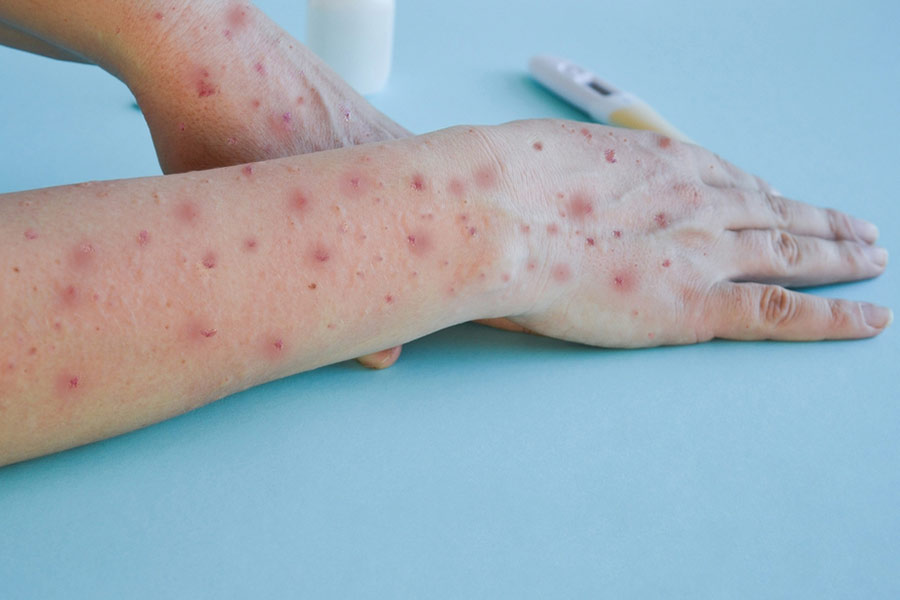The government’s on high alert for mpox, formerly known as monkeypox, which has now spread to 116 countries, including our neighbour Pakistan where nearly a dozen cases have been reported. Pakistan is taking proactive measures, screening all visitors from abroad to prevent further spread.
Following the World Health Organization’s declaration of the mpox outbreak in Africa a global health emergency for the second time since 2022, the Indian government held a planning meeting at the weekend. Despite these developments scientists and doctors urge calm, saying we don’t need to ring the alarm bells yet.
The current epidemic, being driven by a deadlier strain, erupted in the Democratic Republic of Congo (DRC) where over 15,000 cases and 527 deaths have been recorded this year alone. The virus has spread widely to surrounding countries like Rwanda, Congo, Uganda and Burundi and has even reached more distant corners of Africa such as South Sudan and South Africa. There have been 27,000 cases and more than 1,100 deaths, mainly among children, in Congo since the latest outbreak began in January 2023.
In Pakistan, the first reported cases emerged in the Khyber Pakhtunkhwa province and a total of 11 are thought to have been identified currently. The person who first developed mpox in Pakistan had just returned from the Middle East.
The disease which can spread through close contact such as touching, kissing or sex, as well as through contaminated materials like sheets, clothing and needles, has also made its way to Europe where the first case emerged in Sweden.
The European Centre for Disease Prevention and Control says it expects more cases to emerge in the coming days but expresses confidence the disease can be kept in check.
Some 30 cases of mpox have been confirmed in India since 2022 when there was a global outbreak. The last Indian case was in March 2024. But there are no cases right now and the possibility of a wide spread in India is considered unlikely. Nevertheless, the government’s keeping a close eye on foreign travellers. A Union health ministry statement said: “The risk of a large outbreak with sustained transmission is presently low in India.”
Globally, there are two types of mpox prevalent with Clade I considered more likely to cause serious illness or death. Says the World Health Organization (WHO): “The current understanding is that Clade I leads to more severe disease and death than Clade II in the populations where it is endemic.”
Health researchers are seeking to figure out exactly how lethal the new variant, Clade 1b, might be.
But the WHO says this variant has shown increased transmission and severity compared to the strains responsible for the global outbreak in 2022.
Clade IIb, which had prompted the 2022 WHO global warning, spread mainly through sexual contact. The July 2022 outbreak affected nearly 100,000 people, primarily gay and bisexual men, in 116 countries and killed about 200 people. India had reported 27 cases and one death.
Swedish authorities, which reported its first case of Clade 1, said this subtype is spreading primarily through household contacts and frequently infects children. Researchers in DRC are warning it could spread internationally – with potentially more severe symptoms and higher mortality. The strain first emerged in September among sex workers in a DRC mining town.
The DRC has accounted for around 90 per cent of the global cases for the last decade.
Early estimates suggest Clade 1b has a mortality rate of 5 per cent for adults and 10 per cent for children. "It is undoubtedly the most dangerous so far of all the known strains of mpox," Jean Claude Udahemuka, from the University of Rwanda, told Sky News. The Clade 2 strain of which caused the 2022 global outbreak had a mortality rate of less than 0.2 per cent.
The risk of additional international spread of Clade 1b is “very worrying,” WHO Director-General Tedros Adhanom Ghebreyesus said. “We are not dealing with one outbreak of one clade; we are dealing with several outbreaks of different clades in different countries with different modes of transmission and different levels of risk,” he said.
Mpox is closely related to smallpox and this means that older Indians who were vaccinated against smallpox are protected from this epidemic or will suffer only mild symptoms. Smallpox vaccination gives almost 85 per cent protection against mpox, according to experts.
However, smallpox vaccinations were stopped around 1980 when the disease was officially eradicated globally so people under 40 do not enjoy such protection. “People of an older vintage will have protection from the smallpox vaccine they got as kids. That vaccination stopped by 1980, so anyone below 40 years is susceptible,” health veteran Shahid Jameel notes.
Mpox usually shows up with a skin rash or sores that can stick around for two to four weeks. Alongside the rash, people often experience fever, headaches, muscle and back pain, fatigue, and swollen lymph nodes. The virus spreads through direct contact with an infected person, contaminated objects, or even infected animals. To confirm a case of mpox, doctors will test samples from the skin sores.
There are already two licensed vaccines which could be rolled out quickly if the epidemic begins to spread widely. However, production hasn’t been ramped up sharply largely for economic reasons – the vaccines weren’t economical to produce if they were only going to be used in places like DRC and other African countries.
The WHO’s decision to declare mpox as a Public Health Emergency of International Concern or PHEIC could unlock funds to tackle the epidemic in DRC and across Africa.
“There are two licensed vaccines. Their production must be ramped up and not stockpiled in Europe and North America but used in DRC and other African countries,” says Jameel.
One vaccine, Jynneos, was originally developed for smallpox but it is effective against mpox. It is used mainly in the US for at-risk people. Another vaccine, ACAM2000, is a live replicating vaccine and was also originally developed for smallpox.













